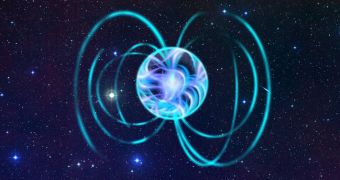A group of investigators has determined that a peculiar type of imploded stars, called magnetars, can explode and release massive amounts of radiation without needing strong magnetic fields, as was previously thought.
Magnetars are a variety of neutron stars, which form after a regular massive star goes supernova. As this happens, its atmosphere is shed and its core collapses in on itself.
The possible results are either a neutron star or a black hole. If the former is formed, then the structure can either remain in its initial shape, or become a magnetar or a pulsar.
Of the two magnetars are the ones that release massive amounts of radiation, while at the same time forming the most powerful magnets in the known Universe.
Even when compared to neutron stars, these structures are thousands of times more magnetic, because they are some of the densest objects ever to be discovered.
To put things into perspective, consider 1.5 to 3 times the mass of the Sun condensed in a ball that is only 12 miles (20 kilometers) in diameter.
Physicists estimate that a teaspoon of matter from a magnetar would weigh as much as an entire mountain on Earth, or around 100 million tons.
But, while experts believed that they had learned a thing or two about these structures, the discovery of SGR 0418+5729 turned things on their heads. The magnetar was found 7,000 light-years away.
Datasets from four X-ray space telescopes were used by Spanish investigators at the Institute of Space Sciences in Barcelona in order to determine how fast the star is spinning.
According to team leader and astrophysicist Nanda Rea, the newly-studied structure had a magnetic field that resembled that of a classic neutron star in intensity.
Generally, magnetars can develop magnetic fields that a million billion gauss in strength. But the new object seems to indicate that common neutron stars “might start behaving as magnetars at anytime, regardless of their low magnetic fields,” Rea says.
“It is the very first time this has been observed and the discovery poses the question of where the powering mechanism is in this case,” adds expert Silvia Zane, quoted by Space.
“At this point, we are also interested in how many of the other normal, low field neutron stars that populate the galaxy can at some point wake up and manifest themselves as a flaring source,” he says in a statement.
The expert is based at the University College London (UCL) and is also the coauthor of a new paper detailing the findings, which was published in the October 15 issue of the top journal Science.

 14 DAY TRIAL //
14 DAY TRIAL //